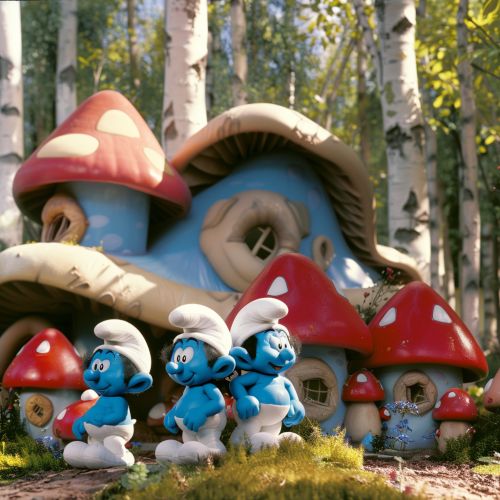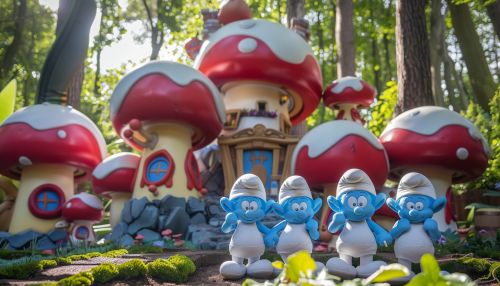Smurfs: Difference between revisions
(Created page with "== History and Origin == The Smurfs are a fictional group of small, blue, human-like creatures that live in mushroom-shaped houses in the forest. They were created by the Belgian comic artist Peyo, whose real name was Pierre Culliford. The Smurfs first appeared in a comic strip titled "Johan et Pirlouit" (Johan and Peewit) on October 23, 1958. The success of these characters led to the creation of their own series of comic books. == Creation and Development ==...") |
No edit summary |
||
| Line 46: | Line 46: | ||
* [[The Smurfs (TV series)]] | * [[The Smurfs (TV series)]] | ||
[[Image:Detail-93257.jpg|thumb|center|Group of Smurfs standing in front of mushroom-shaped houses in a forest.|class=only_on_mobile]] | |||
[[Image:Detail-93258.jpg|thumb|center|Group of Smurfs standing in front of mushroom-shaped houses in a forest.|class=only_on_desktop]] | |||
== References == | == References == | ||
Latest revision as of 05:03, 22 June 2024
History and Origin
The Smurfs are a fictional group of small, blue, human-like creatures that live in mushroom-shaped houses in the forest. They were created by the Belgian comic artist Peyo, whose real name was Pierre Culliford. The Smurfs first appeared in a comic strip titled "Johan et Pirlouit" (Johan and Peewit) on October 23, 1958. The success of these characters led to the creation of their own series of comic books.
Creation and Development
Peyo's creation of the Smurfs was inspired by his love for medieval settings and folklore. The Smurfs' language, characterized by the frequent use of the word "smurf" as a noun, verb, and adjective, added a unique charm to the characters. The Smurfs' society is depicted as a utopian community where each Smurf has a specific role, such as Papa Smurf, Smurfette, and Brainy Smurf.
Comic Series
The Smurfs' comic series expanded rapidly, with numerous albums published over the years. The stories often revolve around the Smurfs' adventures and their encounters with their arch-nemesis, the evil wizard Gargamel and his cat, Azrael. The comics have been translated into multiple languages and have gained a global readership.
Animated Series
The popularity of the Smurfs led to the creation of an animated television series produced by Hanna-Barbera. The series premiered in 1981 and ran for nine seasons, becoming a staple of Saturday morning cartoons. The animated series introduced new characters and expanded the Smurfs' universe, further cementing their place in popular culture.
Cultural Impact
The Smurfs have had a significant impact on popular culture, with their image appearing on a wide range of merchandise, including toys, clothing, and video games. The Smurfs have also been the subject of several feature films, starting with the live-action/animated hybrid film "The Smurfs" in 2011, followed by sequels and spin-offs.
Society and Structure
The Smurfs live in a communal society where each individual has a specific role or job. Papa Smurf is the leader and the oldest of the Smurfs, known for his wisdom and red clothing. Smurfette was originally created by Gargamel to infiltrate the Smurfs' village but was transformed into a real Smurf by Papa Smurf. Other notable Smurfs include Brainy Smurf, known for his intelligence and glasses, and Hefty Smurf, known for his strength.
Language and Communication
The Smurfs' language is a distinctive feature of their culture. They use the word "smurf" as a versatile term that can replace various parts of speech. For example, they might say "I'm feeling smurfy today" or "Let's go smurfing." This playful use of language has become one of the Smurfs' most recognizable traits.
Adaptations and Media
The Smurfs have been adapted into various forms of media, including television series, films, and video games. The animated series produced by Hanna-Barbera is one of the most well-known adaptations. The Smurfs have also appeared in several feature films, including "The Smurfs" (2011), "The Smurfs 2" (2013), and "Smurfs: The Lost Village" (2017).
Merchandise and Commercial Success
The Smurfs have been a commercial success, with their image appearing on a wide range of merchandise. This includes toys, clothing, accessories, and even food products. The Smurfs' popularity has led to the creation of theme parks and attractions dedicated to the characters.
Legacy and Influence
The Smurfs have left a lasting legacy in popular culture. They have been referenced in various forms of media, including television shows, movies, and music. The Smurfs' influence can be seen in the creation of other fictional communities and characters in children's entertainment.
See Also


References
- Culliford, Pierre. "The Smurfs." Le Lombard, 1958.
- "The Smurfs: A History." Animation Magazine, 2011.
- "The World of the Smurfs." Smurfology Journal, 2015.
